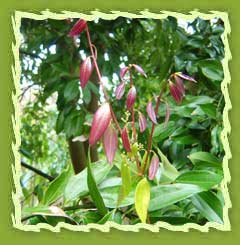A native to Indonesia but cultivated in Sri Lanka and India. The Greek word
'Kinnamon' means 'tube' or 'pipe'. Cinnamon oil was used as a temple
incense, while the Egyptians used it for foot massage as well as a remedy
for excessive bile. It was also used as an ingredient for mulled wines, love
potions and as a sedative during birth. It is derived from the Island's
former name Ceylon.
Description of cinnamon:
The tree grows up to thirty feet tall with leaves that can be four to seven
inches long. The flowers are inconspicuous and the panicles of the yellowish
flowers are usually longer than the leaves. The leaves as well as bark are
the plant parts from which cinnamon oil is extracted. Its oil has
demonstrated strong antibacterial and antifungal activities. Cinnamon Oil is
known for it's peppery, earthy oil that is bright, yet slightly woody scent.
Appearance: Liquid
Aroma : Sweet-spicy, Herbaceous, Peppery, Somewhat
resembling clove & cinnamon, Slightly woody, Powerful exotic and warm.
Color Yellow to brown.
Chemical constituents: Cinnamon oil has various chemical
compounds that include eugenol, eugenol acetate, cinnamic aldehyde and
benzyl benzoate.
ExtractionIt is extracted by steam distillation of leaves.
Cinnamon oil Therapeutic Effects:
It posses therapeutic properties which includes anthelmintic,
antidiarrheal, antidote, antimicrobal, antiseptic, antispasmodic,
antiputrescent, aphrodisiac, astingent, carminative, digestive, emmenagogue,
hemostatic, orexigenic, parasticide, refrigerant, spasmolytic, stimulant,
stomachic and vermifuge.Cinnamon leaf oil has been used for thousands of
years for a variety of complaints including colds, flu, digestive and
menstrual problems, rheumatism, kidney troubles, and as a general stimulant.
Aromatherapy uses:
A unique selection of aromatherapy products including aromatherapy oils,
amber resins, sandal - amber paste, amber resin with box, perfume oils
bottles, diffuser pendants, car and room scenters, light bulb rings,
soapstone aromatherapy oil diffusers.
Cosmetics and toiletries :
Oils are also used in soap making ingredients, lotions, massage oils,
diffusers, potpourri, scent, air fresheners, body fragrance, perfume oils,
aromatherapy products, bath oils, towel scenting, spa's, incense, light
rings, laundry, facial steams and hair treatments.
Cinnamon Oil Kills Mosquitoes.
Cinnamon oil shows promise as a great-smelling, environmentally friendly
pesticide, with the ability to kill mosquito larvae .
Candles and incence :
Uses of smudge sticks : In European and native American countries smudge
incense sticks are used for purifying the atmosphere, dispersing negativity,
protection. Smudges put out a lot of soothing smoke. Very refreshing,
relaxing, clearing --- like traveling through the clouds potent and
purifying. To burn a smudge stick -just light the tip, blow it out and
either wave in air or place in a glass or metal container (one that will not
burn) with sand or salt placed therein to hold the smudge upright.
Flavorings
Cinnamaldehyde is the main constituent in cinnamon leaf oil and is used
worldwide as a food additive and flavoring agent. A formulation using the
compound could be sprayed just like a pesticide, but without the potential
for adverse health effects plus the added bonus of a pleasant smell.It is
mostly used as condiments in candies, souffles and also in the process of
food preservation.
Cinnamon bark oil (Cinnamomum
zeylanicum)
Origin of cinnamon oil:
A native to Indonesia but cultivated in Sri Lanka and India. The Greek word
'Kinnamon' means 'tube' or 'pipe'. Cinnamon oil was used as a temple
incense, while the Egyptians used it for foot massage as well as a remedy
for excessive bile. It was also used as an ingredient for mulled wines, love
potions and as a sedative during birth. It is derived from the Island's
former name Ceylon.
Description of cinnamon bark oil:
The tree grows up to thirty feet tall with leaves that can be four to seven
inches long. The flowers are inconspicuous and the panicles of the yellowish
flowers are usually longer than the leaves. Its oil has demonstrated strong
antibacterial and antifungal activities.
Appearance: Liquid
Aroma: warm, spicy scent
Color: Reddish brown
Chemical constituents: Cinnamon oil has various chemical
compounds that include eugenol, eugenol acetate, cinnamic aldehyde and
benzyl benzoate.
Cinnamon oil Therapeutic Effects:
It posses therapeutic properties which includes anthelmintic,
antidiarrheal, antidote, antimicrobal, antiseptic, antispasmodic,
antiputrescent, aphrodisiac, astingent, carminative, digestive, emmenagogue,
hemostatic, orexigenic, parasticide, refrigerant, spasmolytic, stimulant,
stomachic and vermifuge. Cinnamon Bark essential oil is highly respected as
having antiseptic properties. Some material indicates that it is perfect in
topical applications and with its pleasant scent.From a spiritual
perspective, it is believed to have a warming, uplifting characteristic.
Flavoring agents :
Oil is used for flavoring confectionery and liqueurs. It is also used in
pharmaceutical and dental preparations.Cinnamon can be used as spice flavor,
can be readily oxidized . Some flavors in ground spices tend to volatilize,
causing aroma losses. Cinnamon bark loses its aroma quickly as soon as they
are ground. In addition, the way the spice is treated or processed before
being ground - and the conditions of storage before delivery to the food
processor - create flavor and color differences. Lower-temperature milling
can produce better color, flavor and aroma retention which could be used in
enhancement of flavor.Jamaica and Sierra Leone also boast pungent varieties.
Similarly, cinnamon oil which comes from a dried berry varies in flavor
intensity, depending on its source. Malabar and Lampong variety possess a
high level of nonvolatile eugenol that gives them their characteristic
flavor. They're highly aromatic, while the Malaysian and Brazilian have
milder flavors.
Aromatherapy uses :
Cinnamon bark oils are used as a stimulant for the circulation, as an
antiseptic, as an occasional aphrodisiac. Good for easing arthritis pain,
muscle pain and adding heat to the body, but should only be used when highly
diluted in a carrier oil. Cinnamon is said to increase your ability to tap
into the psychic mind and to increase financial prosperity! Is nice to use
in a room diffuser for that soft warm fuzzy feeling.
